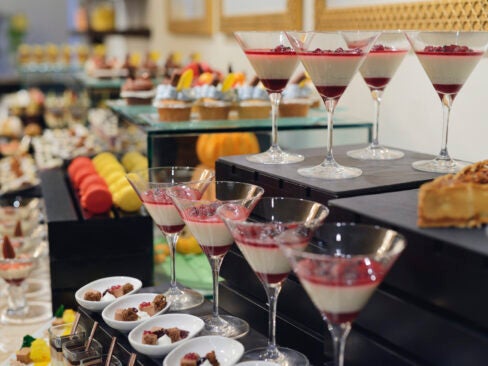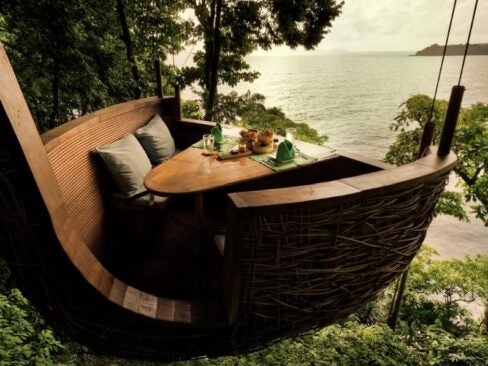One of the world’s oldest culinary commodities, coffee is a force of nature. (Literally.)
Some 2.25 billion cups of the stuff are sipped every day, from bean-growing equatorial regions like Ethiopia and Ecuador, to the legendary cafés of Vienna, Paris and Rome.
While exact origins are up for debate, human beings have been snacking on the red, berry-like fruit of the coffee shrub since 1000 AD. Early on, it was mixed with animal fat to create an ancient energy bar, and fermented to make a highly caffeinated wine.
In the 13th Century, Arabs invented the roasted version of the beverage that (vaguely) resembles the double-skim half-caf coffee drinks we sip today. Pious Muslims who wanted to power through long prayer sessions would parch and boil the beans to create a potent brew.
It wasn’t until the 17th Century that coffee plants traveled outside of the Arab world. Legend has it that a single pilgrim, India’s Baba Budan, carried beans all the way from Mecca to mainland Europe, thereby inaugurating generations of European coffee drinkers.
Apocryphal or no, by 1616, Holland launched its first coffee plantation in South Asia. France began cultivating the crop in its Caribbean outposts, and the Portuguese in Brazil. Soon thereafter, Europe was hooked.
Late adopter America got keen to the bean in the late 18th Century, largely for political reasons. After the Boston Tea Party of 1773, Americans deemed drinking coffee an act of nationalism. Coffee went on to energize Civil War soldiers, caffeinate the cowhands settling the American West, and invigorate California gold seekers.
In typically American style, bean production and packaging was industrialized in the late 19th Century, giving birth to the pre-roasted, pre-ground Maxwell House and Sanka cans that dominated American coffee culture throughout the next 100 years.
Fortunately, in the past 20 years, national culinary interests have matured. Ingredients like extra virgin olive oil and balsamic vinegar, once deemed “ethnic foods,” have become quotidian fare. Naturally, high-quality coffee has become increasingly important to everyday epicures in the United States and worldwide as well. Along with a focus on hand-cultivated beans, properly farmed, roasted, stored and sold, there is a renewed interest in the art of brewing the perfect cup.
Enter this guide to the world’s top coffee machines. From NASA-empowered espresso brewing, to the $20,000 Japanese siphon imported to a quiet San Francisco café, the premier tools of the trade elevate the simple cup to an art form. Get ready to get galvanized. 
Clover, $11,000
Invented by three highly caffeinated Stanford graduates, the Clover brews one exacting cup of coffee at a time.
Its process is similar to French press. Hot water shoots into a brew chamber, as a filter plunges in, eventually pushing the perfectly brewed coffee out, while the grounds rise to the top of the chamber.
A global phenomenon, the Clover is used at top cafes for serious coffee drinkers. At the rabidly popular Stumptown Annex in Portland, OR, for example, every single cup of coffee served is brewed in a Clover. 
Blossom One Limited, $11,111
San Francisco-based Blossom hired top talent from Apple, Tesla and a little start-up called NASA to create this limited-edition java juggernaut.
The Blossom One Limited machine has built-in WiFi so that baristas can download and share brewing recipes specific to individual roasters, plus a 1.3MP camera to scan coffee beans’ QR codes. It has a manual plunger as well as individual modules to control time, temperature, pressure and volume.
A stylish little number, the Blossom One Limited can be custom-designed to combine stainless steel with mahogany, walnut, teak, sapele or zebrawood. 
Bunn Tiger XL-5 2 Super-Automatic Espresso Machine, $12,000
Big things come in small packages with Bunn.
This all-in-one machine can brew up to 180 drinks per hour, has two hoppers for holding nearly four pounds of different beans and takes up less than 16 inches of counter space.
Pod capabilities are included, as is a modular brewing chamber and a digital wand to simultaneously steam and monitor milk temperatures. 
Nuova Simonelli Aurelia Semi-Automatic 3 Group, $13,500
This 220-pound, multi-purpose machine is the official espresso instrument of the World Barista Championships.
The Nuova Simonelli Aurelia has a specially controlled brew boiler to guarantee temperature precision, boiler capacity of 17 liters and adds a bit of style to its Teflon-lined portafilters with sturdy leather handles.
Italy-based Nuova Simonelli has produced espresso machines for over 70 years. 
Concordia Integra 4, $14,950
Percolation pioneer Concordia created the first fully automated espresso machine on the market.
Its Concordia Integra 4 is something of a digital barista. Favored by high-volume venues like hotels, it has two separate grinders and can be used to create iced beverages, espresso, latte, cappuccino, hot chocolate and steeped and blended teas. Try doing all that with a French press. 
Franke Evolution 1 Step, $18,000
Swiss-based Franke’s Evolution 1 Step Super-Automatic Espresso Machine is a mouthful in more ways than one.
The 100-pound machine can produce up to 24 individually programmable beverages, including espresso, lattes, cappuccinos and a variety of iced coffee drinks with the push of a button.
It also contains two grinders and hoppers for different roasts, as well as a high-tech Autosteam wand for steaming milk. 
Concordia Xpress 6 Beverage System, $19,000
The fastest coffee maker in the world, Concordia Xpress 6 is a beverage behemoth.
The 245-pound workhorse combines an espresso machine, single-cup brewer, two grinders and refrigeration capacity for two one-gallon milk containers. It can create more than 1,000 combinations of steamed, brewed, hot and chilled beverages in less than 25 seconds, earning it fans from Alaska Airlines to Bon Appetit magazine. 
Siphon Bar at the Blue Bottle Café, $20,000
At Blue Bottle coffee Meccas in San Francisco and New York City, brewed coffee is raised to an art form.
Imported from Japan, Blue Bottle’s Siphon Bars function via an ancient form of vacuum brewing. The elegant instruments consist of bulbous stacked glass globes, halogen-powered heat and bamboo paddles used to circulate the coffee grounds by hand.
The best siphon brews are completed by hand-stirring no more than four times over the course of 45 – 60 seconds, an impossibly precise procedure favored by obsessive baristas and some of the world’s most serious coffee connoisseurs. 
Javabot at the Roasting Plant, $1,000,000
Not enough ‘bot in your morning brew? Hit up the Roasting Plant, a boutique café with locations in New York City and Detroit.
The Roasting Plant’s $1 million JavaBot machine roasts, grinds and brews the beans for every cup of coffee to order.
A series of clear storage columns contain “green” beans, which the Javabot measures out per cup, then weightlessly transports to the roaster through curved tubes, in order to prevent any breakage in the raw product. Once roasted, the beans are air lifted back through the columns where they mature for no longer than 48 hours, and either packaged or promptly ground and brewed for optimal freshness. Domo arigato, Javabot.








